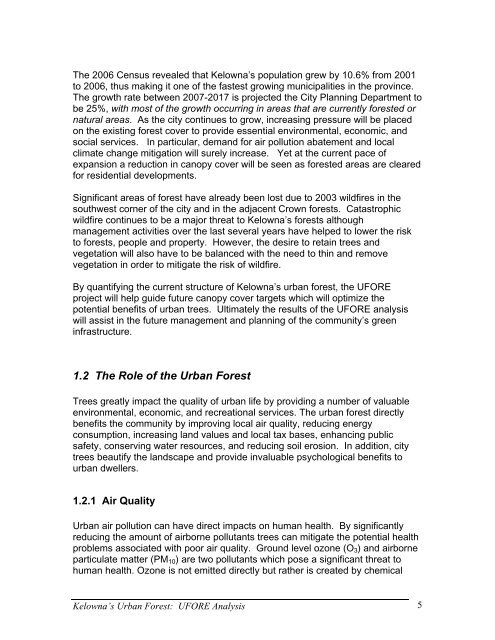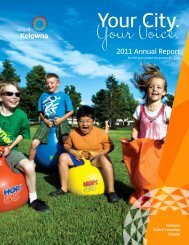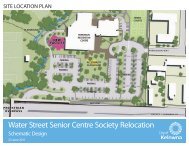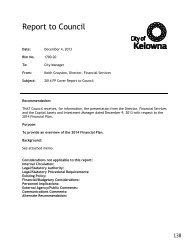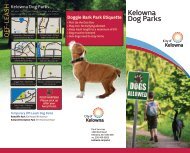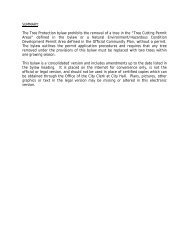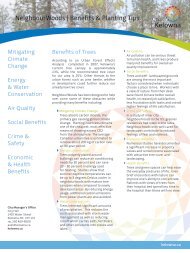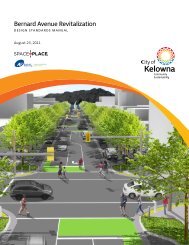Kelowna's Urban Forest: - City of Kelowna
Kelowna's Urban Forest: - City of Kelowna
Kelowna's Urban Forest: - City of Kelowna
You also want an ePaper? Increase the reach of your titles
YUMPU automatically turns print PDFs into web optimized ePapers that Google loves.
The 2006 Census revealed that <strong>Kelowna</strong>’s population grew by 10.6% from 2001<br />
to 2006, thus making it one <strong>of</strong> the fastest growing municipalities in the province.<br />
The growth rate between 2007-2017 is projected the <strong>City</strong> Planning Department to<br />
be 25%, with most <strong>of</strong> the growth occurring in areas that are currently forested or<br />
natural areas. As the city continues to grow, increasing pressure will be placed<br />
on the existing forest cover to provide essential environmental, economic, and<br />
social services. In particular, demand for air pollution abatement and local<br />
climate change mitigation will surely increase. Yet at the current pace <strong>of</strong><br />
expansion a reduction in canopy cover will be seen as forested areas are cleared<br />
for residential developments.<br />
Significant areas <strong>of</strong> forest have already been lost due to 2003 wildfires in the<br />
southwest corner <strong>of</strong> the city and in the adjacent Crown forests. Catastrophic<br />
wildfire continues to be a major threat to <strong>Kelowna</strong>’s forests although<br />
management activities over the last several years have helped to lower the risk<br />
to forests, people and property. However, the desire to retain trees and<br />
vegetation will also have to be balanced with the need to thin and remove<br />
vegetation in order to mitigate the risk <strong>of</strong> wildfire.<br />
By quantifying the current structure <strong>of</strong> <strong>Kelowna</strong>’s urban forest, the UFORE<br />
project will help guide future canopy cover targets which will optimize the<br />
potential benefits <strong>of</strong> urban trees. Ultimately the results <strong>of</strong> the UFORE analysis<br />
will assist in the future management and planning <strong>of</strong> the community’s green<br />
infrastructure.<br />
1.2 The Role <strong>of</strong> the <strong>Urban</strong> <strong>Forest</strong><br />
Trees greatly impact the quality <strong>of</strong> urban life by providing a number <strong>of</strong> valuable<br />
environmental, economic, and recreational services. The urban forest directly<br />
benefits the community by improving local air quality, reducing energy<br />
consumption, increasing land values and local tax bases, enhancing public<br />
safety, conserving water resources, and reducing soil erosion. In addition, city<br />
trees beautify the landscape and provide invaluable psychological benefits to<br />
urban dwellers.<br />
1.2.1 Air Quality<br />
<strong>Urban</strong> air pollution can have direct impacts on human health. By significantly<br />
reducing the amount <strong>of</strong> airborne pollutants trees can mitigate the potential health<br />
problems associated with poor air quality. Ground level ozone (O 3 ) and airborne<br />
particulate matter (PM 10 ) are two pollutants which pose a significant threat to<br />
human health. Ozone is not emitted directly but rather is created by chemical<br />
<strong>Kelowna</strong>’s <strong>Urban</strong> <strong>Forest</strong>: UFORE Analysis 5


